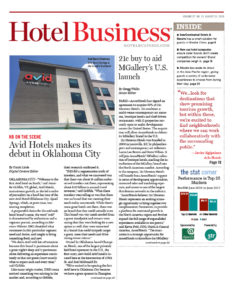 Just a few doors down from Harlem’s renowned Apollo Theater resides another theater that never quite rose to such fame, but still made its mark. The recently restored space may have its second shot at stardom, however, now that it’s home to a major hotel brand, among the first in the area.
Just a few doors down from Harlem’s renowned Apollo Theater resides another theater that never quite rose to such fame, but still made its mark. The recently restored space may have its second shot at stardom, however, now that it’s home to a major hotel brand, among the first in the area.
On West 125th St. in the center of Harlem’s commercial corridor is the historic Victoria Theater. Built in 1917, the NYC theater is now a building block for a new Renaissance hotel, part of Marriott International Inc.’s portfolio, expected to be complete by 2019.
The theater will serve as the entranceway to the 26-story, 211-key Renaissance, along with a 25-story residential building with 191 units, half of which will be affordable.
Designed by Aufgang Architects LLC, the hotel will incorporate the theater’s original charm with all of the conveniences of modern architecture, technology and design.
Although closed due to its deteriorated condition, the theater previously functioned as a multi-screen movie theater. Aufgang Architects plans to uphold the theater’s devotion to the arts and surrounding community with innovative design.
“This will be Harlem’s first world-class hotel, providing valuable resources to the community,” said Ariel Aufgang, principal, Aufgang Architects LLC. “The design includes a new 25,000-sq.-ft. arts center with two theaters with flexible stage and seating arrangements for avant-garde performances, and the offices of established cultural institutions from Harlem.”
The design also includes a 5,000-sq.-ft. ballroom—which can accommodate major political, social, corporate and philanthropic events that previously needed to use facilities in Midtown, Aufgang said—along with 25,000 sq. ft. of retail space.
“Harlem is an economically vital community with a compelling cultural history. The community has long been on the itineraries of visitors to New York City attracted by its unique history and appealing arts, entertainment and culinary destinations,” Aufgang said.
“New York City has an undeniably distinctive and appealing architectural identity. High-profile projects change the skyline. Neighborhoods throughout the city evolve as a result of thoughtful development that enhances their attractiveness and viability, which strengthens the social and economic fabric of these communities,” Aufgang said. “Our design of the Renaissance hotel in Harlem respects the social and cultural context of its site, complements it with innovation and reflects confidence in the continued economic growth of the community.”
Aufgang said that the firm’s engineering and mindful design includes concrete trusses in the walls on the property’s fifth floor that enable it to create a theater with views and seating unobstructed by columns. This way, the community and visitors can enjoy new, large-scale performance spaces with the latest in design technology to enhance their experience.
These experiences, however, don’t just pertain to culture and the arts. Aufgang took other guest concerns into consideration when designing the hotel property.
“Technology allows us to create new and innovative designs in response to a heightened awareness and growing concerns about accessibility, energy usage and the environment,” he said. “The hotel’s design reflects our goal of reducing energy consumption using creative conservation strategies, controlling emissions and saving money. We’ve also incorporated the latest technology and design to enhance accessibility for those with mobility issues.”
 Aufgang said that bathroom layouts in the rooms increase accessibility, with a bathtub that’s in-line along the same wall as the sink and toilet, which makes wheelchair transfer easier. This type of design also creates space for additional shelving and storage, with the elongated wall opposite of the utilities now completely available for use.
Aufgang said that bathroom layouts in the rooms increase accessibility, with a bathtub that’s in-line along the same wall as the sink and toilet, which makes wheelchair transfer easier. This type of design also creates space for additional shelving and storage, with the elongated wall opposite of the utilities now completely available for use.
“We take creative approaches to bring greater ease and convenience to the daily lives of individuals with mobility issues, guided by our desire to apply our imagination and technical know-how to provide the greatest access, utilization and enjoyment to residents across a full spectrum of mobility capability,” Aufgang said.
In addition, guestroom windows can open and close with a push of a switch in ADA-designated rooms.
Along with the modern updates and accessibility features, the theater restoration was important to Aufgang as well, keeping in mind preserving as much as possible from the original architecture, all while making it cohesive with the new hotel design. Aufgang said that the theater’s previous renovations covered and partially protected the original design and other materials, helping with the design process.
“The hotel’s design is literally rooted in Harlem’s history. The preservation and restoration of Harlem’s illustrious cultural and architectural past are evident as the Renaissance rises above the 1917 Victoria Theater and its original terracotta facade,” Aufgang said.
While the Victoria Theater may not have quite the storied history and name recognition that the Apollo bears, what really drew people in years ago was the theater’s design. This included an elaborate staircase and chandelier, all of which Aufgang plans to keep intact for hotel guests and visitors to revel in once again.
“For the first time in nearly 100 years, the Victoria’s ornate lobby will be restored to public use, with its grand staircase and beautiful ceiling meticulously restored,” Aufgang said. “Our approach is a careful blend of adaptive-reuse in the design of Harlem’s first large hotel, of a size heretofore found only in lower Manhattan.” HB

